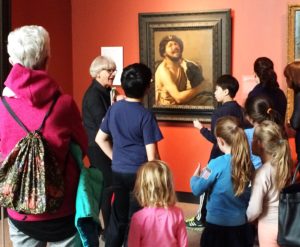Tour Overview
Family Gallery Tours at the Bruce Museum are designed to provide families (with children aged six and up) with an interactive museum experience. Tours encourage conversation and heavily feature open-ended questions. The tours are held almost every Sunday, run about 45 minutes, are free with Museum admission, and require no advanced reservations. Tours are led by docents or museum educators who play the role of moderator- someone to start and keep the conversation going.
Tour Content
Family Gallery Tours are prepared by the docents, so they choose what they want to focus on throughout their tour. This means that the content is always changing and will depend on the current exhibitions. The Museum finds this gives the docents an opportunity to be creative, utilize multiple galleries, and cover various distinctive subjects (as a museum of art and science, they are always looking to tie the two subjects together). The Museum’s exhibitions, especially the art exhibitions, are not always seen by the public as family-friendly. As the education team, educators and docents may not have control over exhibit theme, content, or text, but they do have the chance to create programming to help make the exhibit accessible and welcoming to families. They work to design Family Gallery Tours that interpret exhibition content in a way that multiple family members can understand and appreciate.
Tour Format
Docents always tie in some multi-modal, interactive elements into their tours, whether it is listening to music or participating in mind/art exercises. Docents try to link tour content to authentic, touchable objects in their teaching collection or offer some type of hands-on element during the tour such as sketching, scavenger hunting, or mimicking poses. Docents find this hands-on element is a memorable experience that appeals to both adults and children. Docents use inquiry-based learning and visual thinking strategies to get participants as involved as possible. They want the participants to do most of the talking and thinking as docents lead them to the ‘answers’ (remembering there isn’t always a right or wrong answer). Docents also try to be accessible and incorporate multiple levels of information—scaffolding different ideas and information to fit the abilities of all the participants. An important component of the tour is time for families to independently explore the exhibit space together. Docents may give them a prompt question or a special task to get the conversation started but then they let them run with it. This gives families an opportunity to discuss what they are thinking or feeling with each other without pressure from the docent or other participants. Finally, docents are not afraid to call on tour participants. They like to encourage participation from everyone and that often means asking a grown-up to strike a pose or answer a question.

Tour Goals
The only two things the Museum emphasizes relating to the content of a tour is that it must be distinctive (relate to the current and permanent exhibits) and ‘family-friendly’ (avoid explicit nudity, overly violent subject matter, etc.). They are much more focused on goals of engagement. The Museum seeks to create a welcoming, respectful, and accessible environment for all tour participants, and provide families with a positive, supportive, and engaging museum experience. The Museum also hopes to encourage conversation between family members through discussion using inquiry-based learning and visual thinking strategies, and to build in opportunities for hands-on, object-based experiences, and independent family gallery exploration. The Museum views participants as co-learners and hopes to strengthen relationships between family members in this multi-user program by providing them with shared experiences they can build on. Lastly, the Museum uses family inclusive language and understands that a multi-generational visiting group may be diverse and non-nuclear.
Facilitation Tips and Advice
This is a multi-user program. Throughout the tour, children are a priority (docents always talk in language they understand, etc.) but they let the adults know their participation is welcome and wanted—even if they have call them out a bit and say ‘Grown-ups, what do you think?’ With the open-ended questions and hands-on components of the tour, everyone becomes an active participant. By the end, both children and adults are a lot more comfortable in expressing their thoughts and answering questions.
Educators at the Bruce Museum have some advice for other institutions looking to facilitate family gallery tours:
- Incorporate multiple levels of information
- Encourage discussion between family members, build in time for unstructured/unled discussion
- Connect objects/paintings to everyday life experiences, share stories, spark conversation
- Start dialogues about those life experiences and listen to those experiences
- Use family-inclusive language
- Choose family-friendly spots
- Adapt school tours/existing tours to your needs, you don’t always need to reinvent the wheel
- Use inquiry-based learning and visual thinking strategies
- Include hands-on activities and touchable objects
- Don’t be afraid to act or look silly
Other Family Programs at the Bruce Museum
In addition to the Family Gallery Tours, the Museum offers family gallery guides and activity packs. Gallery guides provide families with information about particular exhibitions, and include simple activities and conversation starters. Activity packs are more hands-on and interactive. Each pack (themed to an exhibit) has 3-5 hands-on activities that families can use in the galleries. The activity packs are free and can be checked out at any time.
Special thanks to Laura Stricker, Manager of Youth and Family Programs, Bruce Museum https://brucemuseum.org/
![]()
